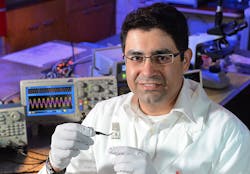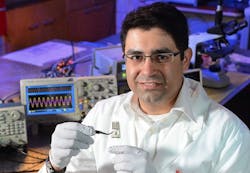Materials Enable Disposable Electronics That Disappear
Used electronics present problems when it’s time to get rid of them. Recycling can be a challenge, and landfills can lead to contamination. Reza Montazami, an assistant professor of mechanical engineering at Iowa State University, has a potential solution with electronics made from special polymers that quickly and completely melt away when triggered.
This file type includes high resolution graphics and schematics when applicable.
Related Articles
- Polymer Fiber Delivers High-Res Remote Imaging
- Using Lithium Polymer Batteries In Portable Devices
- Flexible Chips Take Intelligent Fashion To The Catwalk
“You don’t expect your cell phone to dissolve someday, right?” he asks. “The resistors, capacitors, and electronics, you don’t expect everything to dissolve in such a manner that there’s no trace of it.”
Known as transient materials or transient electronics, these materials have potential applications in multiple applications. For example, medical implants could harmlessly melt away inside a patient once treatment is over. Military surveillance devices could disappear once they have completed their mission, leaving no evidence of their presence. Or, imagine credit cards that can self-destruct if they’re ever lost.
The researchers have developed and tested transient resistors and capacitors. So far, they have developed a blue LED mounted on a clear polymer composite base with electrical leads embedded inside. An added drop of water begins to melt away the base and wiring. The light soon goes out, and a second drop of water degrades what’s left. They also have produced a degradable antenna capable of data transmission (see the figure).
The triggers that instigate the degradation of the electronics are chemical, activated by electric and/or magnetic signals. The encapsulating structures for potential devices can be made of different materials. Montazami expects batteries and organic photovoltaics to serve as power sources.
“Depending on the application, commercial batteries may or may not be suitable,” he said. “For a fully transient device, a transient battery is needed, when a commercial battery can be used for a partially transient device.”
Montazami’s research has not uncovered any mass or size limitations for potential devices yet. Also, some of the materials are biocompatible, suggesting sensors that could be used to detect when food is no longer fresh in addition to medical applications. The research has been supported by startup funds from Iowa State, and Montazami is pursuing grants for additional projects.


